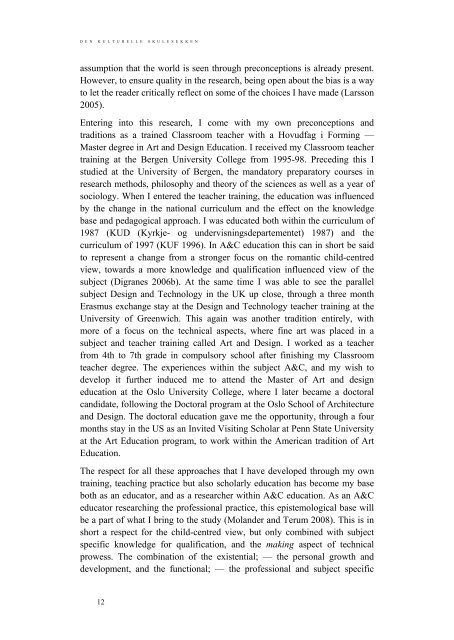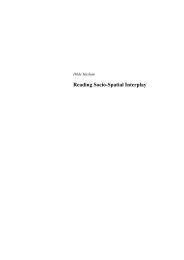CON ⢠TEXT - Arkitektur- og designhøgskolen i Oslo - AHO
CON ⢠TEXT - Arkitektur- og designhøgskolen i Oslo - AHO
CON ⢠TEXT - Arkitektur- og designhøgskolen i Oslo - AHO
- No tags were found...
You also want an ePaper? Increase the reach of your titles
YUMPU automatically turns print PDFs into web optimized ePapers that Google loves.
D E N K U L T U R E L L E S K U L E S E K K E Nassumption that the world is seen through preconceptions is already present.However, to ensure quality in the research, being open about the bias is a wayto let the reader critically reflect on some of the choices I have made (Larsson2005).Entering into this research, I come with my own preconceptions andtraditions as a trained Classroom teacher with a Hovudfag i Forming —Master degree in Art and Design Education. I received my Classroom teachertraining at the Bergen University College from 1995-98. Preceding this Istudied at the University of Bergen, the mandatory preparatory courses inresearch methods, philosophy and theory of the sciences as well as a year ofsociol<strong>og</strong>y. When I entered the teacher training, the education was influencedby the change in the national curriculum and the effect on the knowledgebase and pedag<strong>og</strong>ical approach. I was educated both within the curriculum of1987 (KUD (Kyrkje- <strong>og</strong> undervisningsdepartementet) 1987) and thecurriculum of 1997 (KUF 1996). In A&C education this can in short be saidto represent a change from a stronger focus on the romantic child-centredview, towards a more knowledge and qualification influenced view of thesubject (Digranes 2006b). At the same time I was able to see the parallelsubject Design and Technol<strong>og</strong>y in the UK up close, through a three monthErasmus exchange stay at the Design and Technol<strong>og</strong>y teacher training at theUniversity of Greenwich. This again was another tradition entirely, withmore of a focus on the technical aspects, where fine art was placed in asubject and teacher training called Art and Design. I worked as a teacherfrom 4th to 7th grade in compulsory school after finishing my Classroomteacher degree. The experiences within the subject A&C, and my wish todevelop it further induced me to attend the Master of Art and designeducation at the <strong>Oslo</strong> University College, where I later became a doctoralcandidate, following the Doctoral pr<strong>og</strong>ram at the <strong>Oslo</strong> School of Architectureand Design. The doctoral education gave me the opportunity, through a fourmonths stay in the US as an Invited Visiting Scholar at Penn State Universityat the Art Education pr<strong>og</strong>ram, to work within the American tradition of ArtEducation.The respect for all these approaches that I have developed through my owntraining, teaching practice but also scholarly education has become my baseboth as an educator, and as a researcher within A&C education. As an A&Ceducator researching the professional practice, this epistemol<strong>og</strong>ical base willbe a part of what I bring to the study (Molander and Terum 2008). This is inshort a respect for the child-centred view, but only combined with subjectspecific knowledge for qualification, and the making aspect of technicalprowess. The combination of the existential; — the personal growth anddevelopment, and the functional; — the professional and subject specific12
















